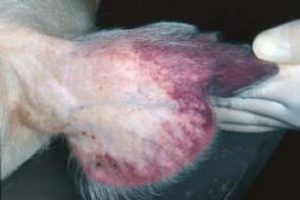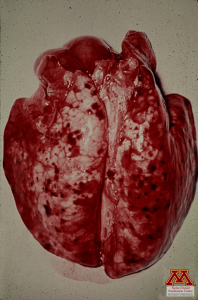Reportable and Transboundary Diseases
African Swine Fever
Clinical Importance
African Swine Fever is a disease in the reportable list of the OIE (World Organization for Animal Health). Any country infected by the virus is banned from export of any pork product, leading to disastrous consequences on the swine industry economy. For example, pork export represents $4.6 billion in revenues, driving economic sustainability for hog farmers. In 2018, the virus has spread across China and expended from Poland to Belgium. It is considered one of the most significant threats to the US pork production today. The African Swine Fever virus only affects swine species. It is not highly infectious but can cause severe mortality, depending on the strain.
Etiology and Transmission
African Swine Fever virus is the only member of the Asfarviridae family. The DNA virus is large and enveloped making it extremely resistant in the environment. Its structure is complex There are several genotypes found across the world. Genotype 2 spread to Asia and Eastern Europe whereas Genotype 1 is found in Africa.
Warthogs are healthy carriers of the virus. In Africa, the spread of the disease occurs indirectly through a soft tick species (Ornithodorus spp.). Once fed, the tick can survive for 5 years without a meal and infect a new warthog with the virus during its next feeding.
In Europe and Asia, the virus is transmitted through the blood of infected animals. Direct between pigs or indirect contact through contaminated fomites such as boots or trucks can be a source of contamination. The European wild boar population is infected, expressing clinical signs and sometimes dying from infection. Wild boars represent a strong risk of contamination for outdoor, backyard production, commonly seen in Eastern Europe. Additionally, the virus is extremely resistant and can survive in cooked, cured, or smoked pork products. This is the reason why feeding kitchen waste to hogs is prohibited in numerous countries, including the United States.
Associated Symptoms

The virus damages the endothelial cells of blood vessels and is therefore associated with hemorrhages and edema. In the early stages, the clinical presentation is non-specific. Pigs are anorexic and recumbent, and huddled together for warmth. Bloody diarrhea, vomit, and nasal discharge can be noted as well as petechiae on the skin. Although some strains cause mortality in 7 to 10 days, it is important to note that some of them lead to chronically infected animals.
Associated Lesions

Macroscopic Lesions
At necropsy, the carcass of the animal seems hemorrhagic. Skin hemorrhages usually start around the ears and then spread out on the body. Petechiae and hemorrhages can be found on all organs (heart, kidneys, intestines, lymph nodes). Another recurring lesion of African Swine Fever is a severely enlarged, dark, and friable spleen.
Microscopic lesions
Hemorrhages and microthrombosis associated with the destruction of endothelial cells are seen in most organs with histopathology. In severe cases, the spleen loses its cellular structure.
Diagnosis
Whole blood and tonsils are the only two sample types that are approved by the USDA for the testing of African Swine Fever. The samples are tested by PCR. Oral fluids are being investigated and may be approved soon. The virus attaches to the erythrocytes, therefore any hemorrhagic tissue can be a good candidate for testing. However, serum samples are not recommended.
Differential diagnosis
The early stages of infection can be similar to PRRS, Streptococcus suis, Salmonella choleraesuis, or even Influenza (pyrexic diseases). The differential for bloody diarrhea needs to include Brachyspira hyodysenteriae, Lawsonia intracellularis, and gastric ulcers.
Treatment, Prevention, and Control
There is no treatment against African Swine Fever. There is no vaccine on the market against African Swine Fever. The proteins constituting the virus are complex and until now, the attempts to create a vaccine have not been able to produce neutralizing antibodies. In fall 2018, Zoetis received patents from the USDA to facilitate the creation of a vaccine.
In case of an outbreak in a naive country, the government would stop all swine movement and cull all of the animals in the infected and neighboring farms.
The prevention of the disease relies on tight biosecurity measures. The virus does not spread through aerosols. In a confined production setting, it is a human-spread disease.

